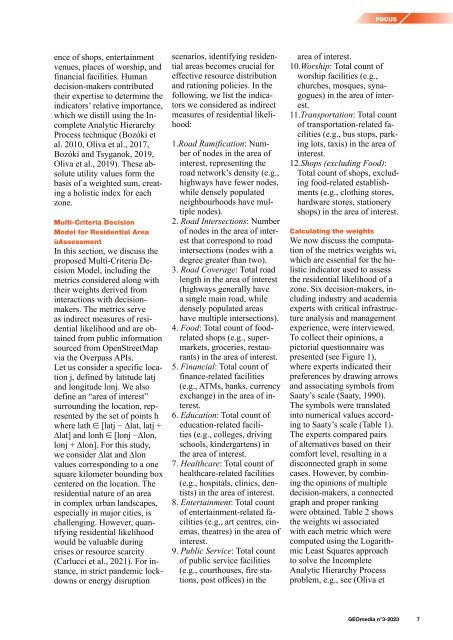GEOmedia_3_2023
EUMAP During the recent pandemic period, the world's attention has shifted towards the healthcare sector, with world leaders striving to avoid the collapse of their national healthcare systems; the economy has entered an artificial coma, while utility systems, including energy, water, telecommunications and waste management systems, have been asked to act immediately in response to these unprecedented conditions, placing extreme pressure on public utility systems.
EUMAP
During the recent pandemic period, the world's attention has shifted towards the healthcare sector, with world leaders striving to avoid the collapse of their national healthcare systems; the economy has entered an artificial coma, while utility systems, including energy, water, telecommunications and waste management systems, have been asked to act immediately in response to these unprecedented conditions, placing extreme pressure on public utility systems.
Create successful ePaper yourself
Turn your PDF publications into a flip-book with our unique Google optimized e-Paper software.
FOCUS<br />
ence of shops, entertainment<br />
venues, places of worship, and<br />
financial facilities. Human<br />
decision-makers contributed<br />
their expertise to determine the<br />
indicators’ relative importance,<br />
which we distill using the Incomplete<br />
Analytic Hierarchy<br />
Process technique (Bozóki et<br />
al. 2010, Oliva et al., 2017,<br />
Bozóki and Tsyganok, 2019,<br />
Oliva et al., 2019). These absolute<br />
utility values form the<br />
basis of a weighted sum, creating<br />
a holistic index for each<br />
zone.<br />
Multi-Criteria Decision<br />
Model for Residential Area<br />
ùAssessment<br />
In this section, we discuss the<br />
proposed Multi-Criteria Decision<br />
Model, including the<br />
metrics considered along with<br />
their weights derived from<br />
interactions with decisionmakers.<br />
The metrics serve<br />
as indirect measures of residential<br />
likelihood and are obtained<br />
from public information<br />
sourced from OpenStreetMap<br />
via the Overpass APIs.<br />
Let us consider a specific location<br />
j, defined by latitude latj<br />
and longitude lonj. We also<br />
define an “area of interest”<br />
surrounding the location, represented<br />
by the set of points h<br />
where lath ∈ [latj − ∆lat, latj +<br />
∆lat] and lonh ∈ [lonj −∆lon,<br />
lonj + ∆lon]. For this study,<br />
we consider ∆lat and ∆lon<br />
values corresponding to a one<br />
square kilometer bounding box<br />
centered on the location. The<br />
residential nature of an area<br />
in complex urban landscapes,<br />
especially in major cities, is<br />
challenging. However, quantifying<br />
residential likelihood<br />
would be valuable during<br />
crises or resource scarcity<br />
(Carlucci et al., 2021). For instance,<br />
in strict pandemic lockdowns<br />
or energy disruption<br />
scenarios, identifying residential<br />
areas becomes crucial for<br />
effective resource distribution<br />
and rationing policies. In the<br />
following, we list the indicators<br />
we considered as indirect<br />
measures of residential likelihood:<br />
1.Road Ramification: Number<br />
of nodes in the area of<br />
interest, representing the<br />
road network’s density (e.g.,<br />
highways have fewer nodes,<br />
while densely populated<br />
neighbourhoods have multiple<br />
nodes).<br />
2. Road Intersections: Number<br />
of nodes in the area of interest<br />
that correspond to road<br />
intersections (nodes with a<br />
degree greater than two).<br />
3. Road Coverage: Total road<br />
length in the area of interest<br />
(highways generally have<br />
a single main road, while<br />
densely populated areas<br />
have multiple intersections).<br />
4. Food: Total count of foodrelated<br />
shops (e.g., supermarkets,<br />
groceries, restaurants)<br />
in the area of interest.<br />
5. Financial: Total count of<br />
finance-related facilities<br />
(e.g., ATMs, banks, currency<br />
exchange) in the area of interest.<br />
6. Education: Total count of<br />
education-related facilities<br />
(e.g., colleges, driving<br />
schools, kindergartens) in<br />
the area of interest.<br />
7. Healthcare: Total count of<br />
healthcare-related facilities<br />
(e.g., hospitals, clinics, dentists)<br />
in the area of interest.<br />
8. Entertainment: Total count<br />
of entertainment-related facilities<br />
(e.g., art centres, cinemas,<br />
theatres) in the area of<br />
interest.<br />
9. Public Service: Total count<br />
of public service facilities<br />
(e.g., courthouses, fire stations,<br />
post offices) in the<br />
area of interest.<br />
10.Worship: Total count of<br />
worship facilities (e.g.,<br />
churches, mosques, synagogues)<br />
in the area of interest.<br />
11.Transportation: Total count<br />
of transportation-related facilities<br />
(e.g., bus stops, parking<br />
lots, taxis) in the area of<br />
interest.<br />
12.Shops (excluding Food):<br />
Total count of shops, excluding<br />
food-related establishments<br />
(e.g., clothing stores,<br />
hardware stores, stationery<br />
shops) in the area of interest.<br />
Calculating the weights<br />
We now discuss the computation<br />
of the metrics weights wi,<br />
which are essential for the holistic<br />
indicator used to assess<br />
the residential likelihood of a<br />
zone. Six decision-makers, including<br />
industry and academia<br />
experts with critical infrastructure<br />
analysis and management<br />
experience, were interviewed.<br />
To collect their opinions, a<br />
pictorial questionnaire was<br />
presented (see Figure 1),<br />
where experts indicated their<br />
preferences by drawing arrows<br />
and associating symbols from<br />
Saaty’s scale (Saaty, 1990).<br />
The symbols were translated<br />
into numerical values according<br />
to Saaty’s scale (Table 1).<br />
The experts compared pairs<br />
of alternatives based on their<br />
comfort level, resulting in a<br />
disconnected graph in some<br />
cases. However, by combining<br />
the opinions of multiple<br />
decision-makers, a connected<br />
graph and proper ranking<br />
were obtained. Table 2 shows<br />
the weights wi associated<br />
with each metric which were<br />
computed using the Logarithmic<br />
Least Squares approach<br />
to solve the Incomplete<br />
Analytic Hierarchy Process<br />
problem, e.g., see (Oliva et<br />
<strong>GEOmedia</strong> n°3-<strong>2023</strong> 7

















